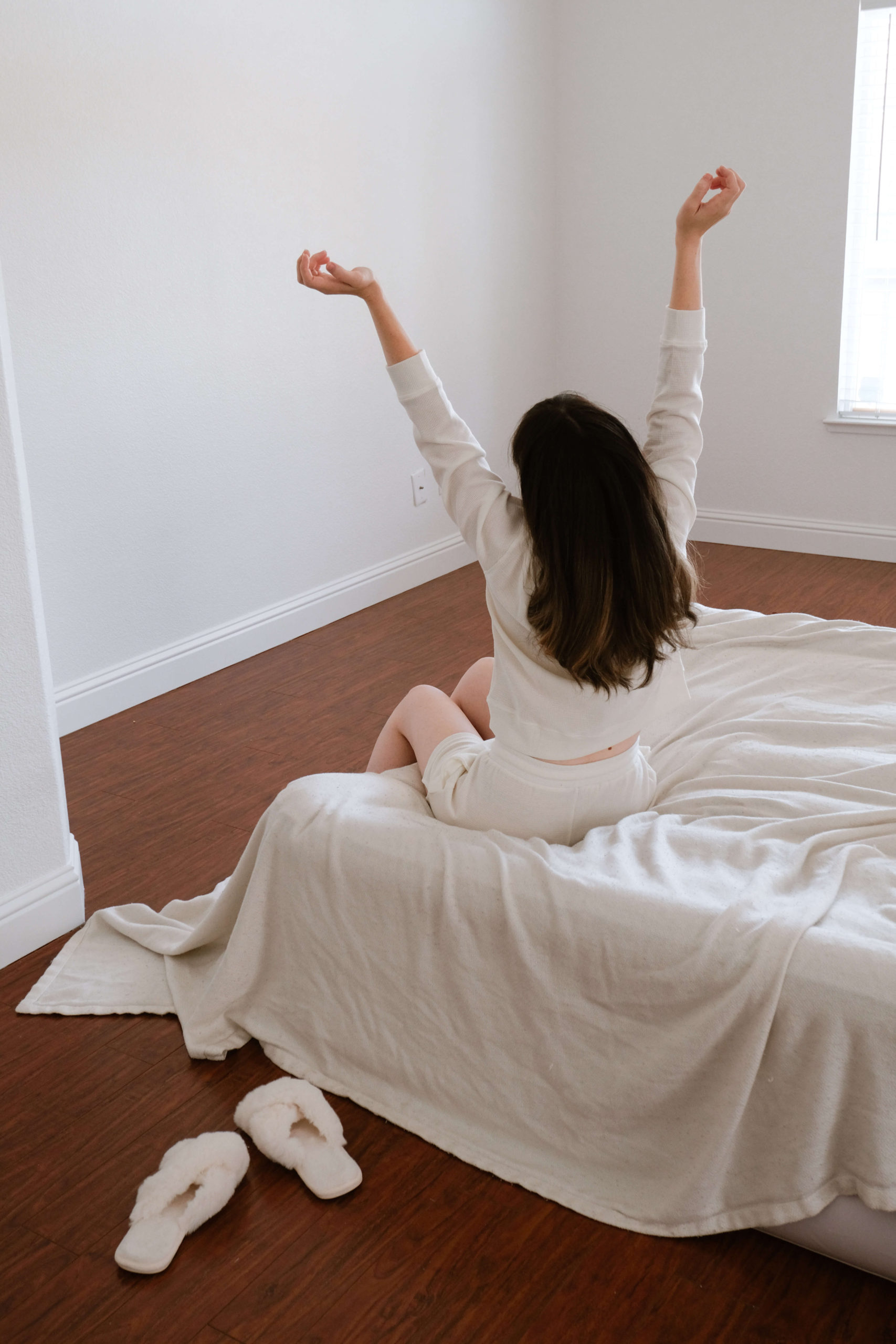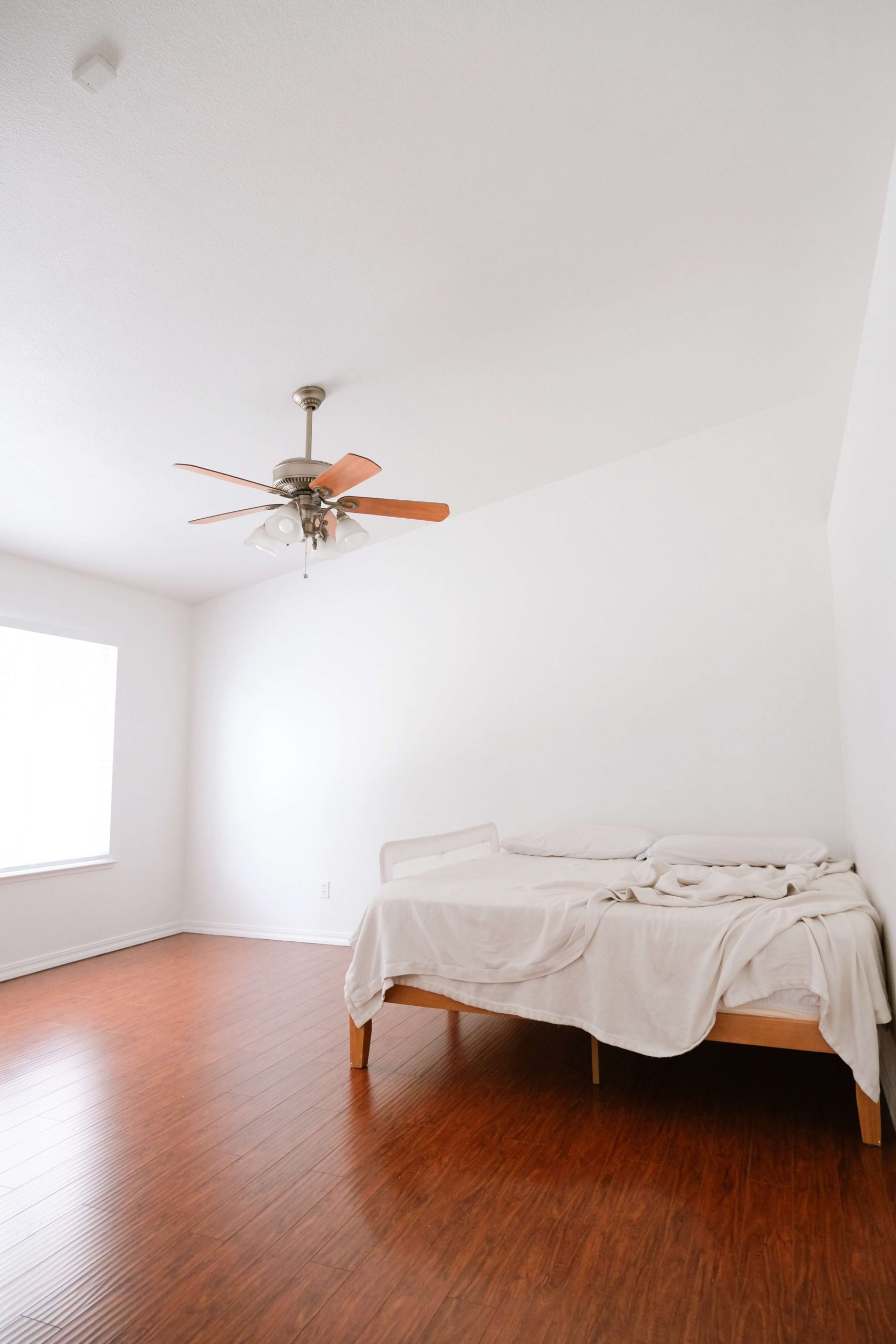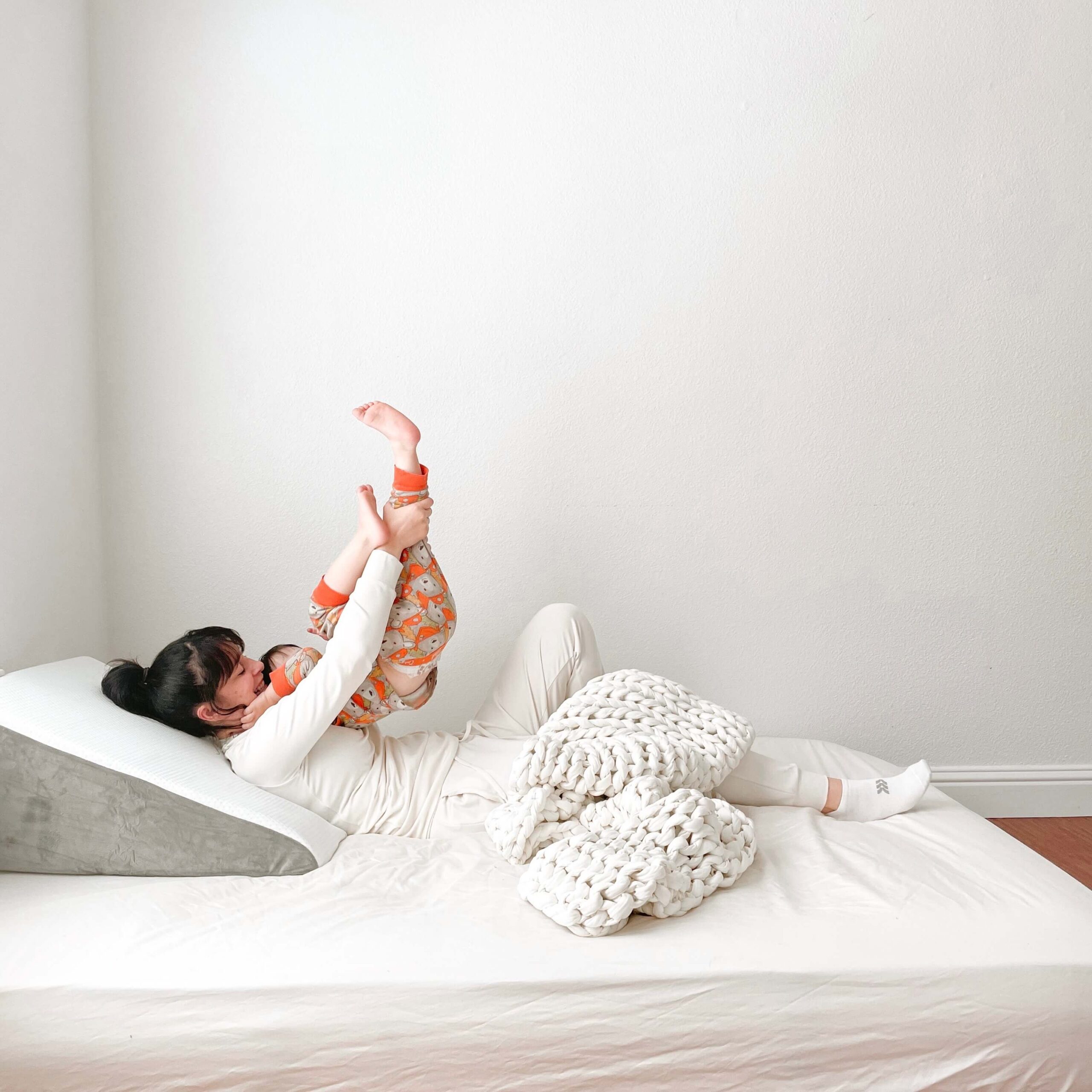Many parents believe that if they invite their child into their bed, they will never leave. But you can stop bedsharing with your baby or toddler at any point by gently transitioning them to a floor bed in your bedroom.
How to Stop Bedsharing
- Commit to Putting a Mattress on the Floor
- Establish Boundaries with Your Partner
- Discuss the Transition With Your Child
- Choose a Floor Bed & Childproof Your Bedroom
- Sleep with Your Child on the Floor Bed
- Gradually Decrease Your Time on the Floor Bed
When the time comes, many parents assume the next step is to put their child in a toddler bed in his own room. But this can be traumatizing for a child who is used to sleeping against his mother’s body. There is a much better way to transition your child out of your bed.
1. Commit to Putting a Mattress on the Floor
Parents often say that they want to stop bedsharing, but they decide against it when they realize this means that they’ll have to put a separate mattress on the floor of their bedroom. They often don’t want to do that, for aesthetic, financial, or practical reasons.
So before you start the long, emotional journey of transitioning your baby or toddler out of bedsharing, make sure that you’re ready to set up a floor bed in your bedroom.
This way, you’ll start your baby on the floor bed at the beginning of the night, and you’ll have a variety of options as the night goes on. You can either resettle them there and return to your bed, bedshare with them on their floor bed, or bedshare with them in your bed.
There are lots of options! You’ll have a freedom that you don’t have right now — there will be a separate, safe surface for them to sleep if need be.
What is a Floor Bed?
A floor bed is usually an adult-sized mattress placed on the floor of the parents’ bedroom. While the mattress can be child-sized, most parents choose a large one so they can comfortably lie down to nurse or bedshare part time.
A floor bed can accommodate a child of any age — in fact, those who follow the Montessori philosophy give their infant a floor bed at birth. They believe a floor bed fosters independence, autonomy, respect, and the freedom to explore.
Lauren Levine, holistic sleep specialist and founder of Gold Dust Lactation & Sleep, often recommends floor beds to families transitioning out of bedsharing.
Levine believes floor beds are “especially great for bedsharing-to-independent sleep transitions because the supporting parent can lay right there next to the baby.”
A breastfeeding mother can nurse her child to sleep at night — just as she did on the family bed. She can jump down and sleep with him following a nightmare. She can be beside her child within seconds, if need be.
Why Should the Floor Bed be in Your Room?
The close proximity of a floor bed preserves many of the beneficial aspects of bedsharing that would be lost if a child were moved to a separate bedroom.
If you set up a floor bed in your own bedroom, you may only need to buy a mattress.
The amount of sleep you can expect on an average night will likely be the same as when you were bedsharing.
But if you were to set up a toddler bed in another bedroom, you may need to purchase the mattress, frame, a baby monitor, and a baby gate to keep your toddler inside his bedroom all night.
The amount of sleep you can expect on an average night will depend on your child’s ability to fall back asleep on his own.
If he can fall asleep without your help, you will probably sleep more than you did when you were bedsharing.
However, if he needs your help falling back asleep, you will have to walk down the hall to his bedroom each and every time he wakes up. You will probably sleep less than you did when you were bedsharing.

2. Establish Boundaries with Your Partner
When you have thoroughly assessed the costs and benefits to both options, and you have decided on a floor bed, sit down with your partner. Look at the calendar to see if any big life events are coming up in the next few months.
Try not to make the transition during any big changes, such as weaning, potty training, starting day care, having company in your home or moving.
The New York Times
When Should You Stop Bedsharing?
There isn’t one, “right” time to stop bedsharing.
Check in with yourself — your intuition, emotions, and physical reactions when you think about the transition. For example, does your stomach clench up when you think about stopping bedsharing before your big holiday?
Check in with your partner. If you both think this is the right time to begin the process, discuss the boundaries you want to create:
- Is your child allowed to come up onto your bed during the night? If so, under what circumstances? (e.g. if he’s sick, teething, has a nightmare, wets the bed, etc.)
- If not, when will each parent be expected to jump down to sleep on the floor bed with your child? (e.g. if he needs to nurse, Mom will move to the floor bed. If he has a nightmare, it’s Dad’s turn. And so on.)
- In the case that your child wakes up before you in the morning, what are you comfortable with him doing on his own? (e.g. playing quietly with toys on the floor, watching Caitie’s Classroom on your iPad, etc.)
You and your partner need to be on the same page. This transition will not be easy for most toddlers, and any tension or inconsistency between you two will make it more challenging.
3. Discuss the Transition With Your Child
Begin talking to your child about his transition to a floor bed as soon as you and your partner have decided on boundaries.
Talk to your child about his new floor bed for two weeks. Change is extremely difficult for toddlers, but it helps when they know exactly what’s going to happen. Clearly explain the boundaries that you and your partner have established.
If you want to buy a frame, instead of just putting the mattress on the floor, look for low bed frames. Ask his opinion — does he want to put a dinosaur tent over it? Does he want you to stick glow-in-the-dark stars on the ceiling above it?
Help your child feel like he is a participant in this process. It will help him feel like he has some sense of control over what is happening to him.
Give him the space to experience and express all of his feelings about this change. If he wants to ask you about his new floor bed every single hour during the day, try to oblige and explain it to him for the hundredth time.
How Can You Make it Easier for Your Child to Stop Bedsharing?
This is a major change for him. Remind him that he is not going to be in another room. He will be just feet away from you, and you will continue being there for him all night long, just as you have been.
If you haven’t already established strong sleep associations, this two-week period of time is when you should introduce some. This could be a white noise machine or a special night light that you turn on right before saying goodnight.
Make sure you solidify your nighttime routine. Is it always bath, brush teeth, bedtime story, day recap by Daddy, goodnight kisses?
If so, the exact same thing needs to happen in two weeks — the one and only thing that will be different is you are doing these things down on the floor bed instead of up on the family bed. If your family’s rhythm and flow is the same, it will be much easier to stop bedsharing.
4. Choose a Floor Bed & Childproof Your Bedroom
During this time, purchase the mattress and accessories that resonated with your child.
He may not want to stop bedsharing, but I bet something got him excited. Was it a tent, LED lights or candles, or the new lovey that arrives with the floor bed? If your child is at least a year old, would he like a new stuffed animal or a special blanket? (Pillows are not recommended until age two.)
If you’ll want a night light, browse this list of 50+ lights that are safe for little wandering hands in the middle of the night.
Before you buy anything, make sure that it aligns with child safety guidelines. If you plan on sleeping on the floor bed with your child at any point, follow safe bedsharing guidelines.
The mattress you choose should be firm. Here is a list of firm, low-profile mattresses.
Do not place it against a wall or furniture, which could accidentally lead to entrapment or suffocation. It should be at least 2 feet (60 cm) away, according to Dr. James McKenna.
Specifically look for low bed frames. But if you are still worried about it being too high, buy a mesh bed rail for the sides.
Pro Tip – If you simply want to put a mattress on the floor, put bed slats underneath to keep mold from growing.
Even if you and your partner do not want your child roaming free in the mornings while you are still sleeping, plan on it happening anyway. You need to completely childproof the room, as if your child’s life depends on it.
How Should You Childproof Before You Stop Bedsharing?
Consider these problem areas:
- Bookcases — Remove bookcases from the bedroom. In the case that you cannot, anchor the bookcase to a wall stud and place the heaviest items on the bottom shelves.
- Hard edges — Stick a cushy bumper on any hard edges, in case your child trips and falls on one (e.g. bookcases, side tables, etc.).
- Lights — Remove floor lamps from bedroom. Plug night lights into high outlets, out of your child’s reach.
- Outlets — Cover all plugs in floor-level outlets with plastic covers. Try to keep cords plugged into outlets that are covered by furniture and are not easily-accessible.
- Heat sources — Block access to your heater, radiator, or fireplace.
- Nightstands — Anchor the nightstand to a wall stud, adhere foam bumpers to sharp corners, add cabinet locks, and remove anything dangerous from drawers (e.g. cuticle scissors, medication, etc.).
- Toys — Remove all toys that could be choking hazards. Assess toys to see if your child could throw it, climb on it, or use it to hurt someone.
- Windows — Lock all windows, and tie up blind cords so they are not dangling.
5. Sleep with Your Child on the Floor Bed
When the floor bed finally arrives, act like it is the best hangout spot in the house.
Spend a lot of time there. Naps, playtime, and nights. Sleep with your child on the floor bed for two weeks.
“The objective is to create predictable patterns and positive sleep associations. Practice with one nap in the floor bed, even if you are laying with him the whole time. Play games with him there during the day. Most babies will protest the separation from their caregiver more than the space itself, so let him get very familiar and comfortable with the space while you are right there with him.”
Lauren Levine
This is the time when your child’s sleep associations and nighttime routine will be pivotal in providing comfort.
After you’ve been sleeping together on the floor bed for a few days, begin talking to him about the next transition — you moving back up to your bed.
Just as before, explain everything to him in detail. Answer all his questions about why you two really do, finally, have to stop bedsharing when they pop up, day or night.
Go through those boundaries with him, again, so he knows exactly what to expect.
He may be sad to know that you will leave the floor bed after he falls asleep. But he will be comforted to know that you will come back and finish the night with him on his bed after he wakes up to use the potty.
Maybe his dad works a few night shifts each week, and on those nights he can join you on the family bed until Daddy comes home at 2 o’clock.
Each family’s flow will be different. There is no one, “right” way to cosleep or room-share. The important part is open, honest communication. Even though your child is young, he deserves respect and gentleness throughout this process.
6. Gradually Decrease Your Time on the Floor Bed
After spending two full weeks bedsharing with your child on his floor bed, if you feel like he is ready, you can begin transitioning back to your bed.
By this point, he should have two weeks’ worth of happy memories on his new bed. He had time to grapple with his new role as a partially-independent sleeper. And by now his fitted sheet should smell like you, which is comforting.
If your toddler is at least a year old, make sure he always sleeps in socks to avoid unnecessary wakeups due to being chilly. A warm blanket can help him feel cocooned and safe.
Pro Tip – Throw your toddler’s blanket in the dryer for ten minutes before bed if he likes to be extra cozy.
If your baby is younger than a year old, overheating is a risk factor for SIDS. A baby should never sleep with a blanket. Help him sleep comfortably by dressing him in footie pajamas or a sleep sack.
Decrease your time on the floor bed ever-so gradually.
Maybe you continue sleeping with him all night for a while longer, but you sneak away at nap time. Stay close, so you’ll know when he wakes up.
This will show him that you’re always nearby, even when he suddenly finds himself alone on his bed.
Or maybe you sleep with him until his second feed of the night, which is usually around 3 o’clock. Then after you nurse him back to sleep, you climb up to your bed to finish the night beside your partner.
How Long Will it Take to Finally Stop Bedsharing?
Expect this part of the process to last for a few weeks. And even after you’re “finished” with the transition, prepare for teething, potty learning, or sleep progressions to interfere for weeks at a time.
Your patience and compassion will be worth it in the long run. Your child will know that your love and devotion remains, even when you stop bedsharing and sleep separately. It may not seem like it right now, but this will strengthen your relationship.
And it will make the transition to a toddler bed in a separate room much easier, when that time comes.
Disclaimer: If you make a purchase through an affiliate link, I may receive a small commission at no additional cost to you.







[…] night light you ultimately choose, make sure to safety-proof the entire room in case your child wakes up and starts […]